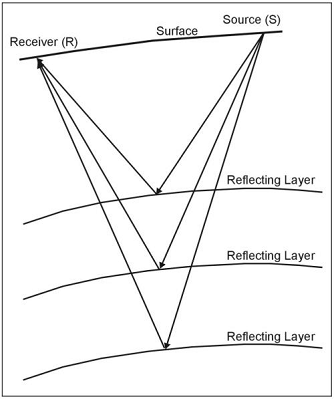Total time required for seismic wave to travel through the rock towards the seismic receiver:
T_x = \int_0^{L_x} \frac{dl}{V_p(l)} |
where
is cartesian coordinates in 3D space with
-axis aligned between seismic source and seismic sensor,
-axis is traversal to
-axis and
-axis is oriented towards Earth centre,
is a lateral offset between the seismic source and seismic receiver
– trajectory of reflection wave from seismic source @
and seismic receiver @
is differential element of the distance along the reflection travel trajectory,
is p-wave velocity of rocks found at travel point
.

In relatively simple geological structures the travel time can be approximated by a Dix equation:
T^2_x = T^2_0 + \frac{4 x^2}{V^2_{rms}} |
where is reflection time at zero offset (which means the normal incident wave reflection):
T_0 = 2 \cdot \int_0^H \ \frac{\delta z}{V_p(z)} |
where is the depth of the reflecting boundary,
– average p-wave velocity through the reflecting travel distance between the seismic source and seismic receiver:
V^2_{rms} = \frac{\sum_i^N V_p^2(t_i) \, \delta t_i}{\sum_i^N \delta t_i}= \frac{\sum_i^N V_p(t_i) \, \delta h_i}{\sum_i^N \frac{\delta h_i}{V_p(t_i)}} |
where
is p-wave velocity of rocks found at travel time
,
is travel time through the rock element of thickness
in tghe rock element found at travel time
.